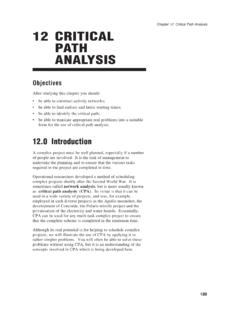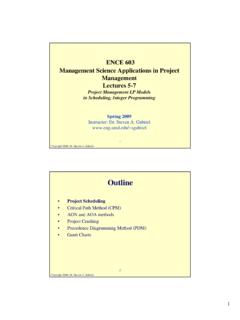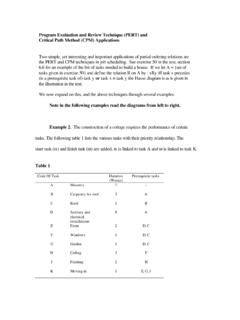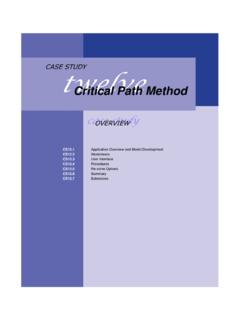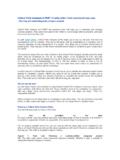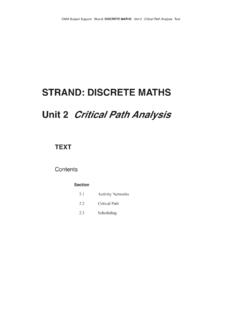Transcription of Calculating Critical Path & Float for a Network Diagram
1 Task Name, Duration (D) Late Finish (LF) Early Finish (EF) Late Start (LS) Early Start (ES) Calculating Critical path & Float for a Network Diagram Find out the length of all the paths in the Network Diagram The longest path is the Critical path Float = EF - LF = ES - LS Calculating Critical path for a Network Diagram Task 1 4 days Task 2 5 days Task 3 3 days Task 4 7 days Task 5 4 days Identify tasks, durations & dependencies. Step 1: Draw a Network Diagram Task 1, 4 days Task 2, 5 days Task 3, 3 days Task 4, 7 days Task 5, 4 days 0 4 4 9 14 18 4 7 7 14 Task 5 is dependent on Task 2 and Task 4 being complete.
2 So, ES for Task 5 is 14 days (dependent on Task 4, which is the longer task. For forward pass, calculate the Early Start (ES) and Early Finish (EF). Step 2: Determine Critical path Length of all tasks: Task1 Task2 Task5 = 4 + 5 + 4 = 13 days Task1 Task3 Task4 Task5 = 4 + 3 + 7 + 4 = 18 days The longest path is the Critical path Critical path = longest path = 18 days Critical path = Task1 Task3 Task4 Task5 To determine Critical path , calculate length (durations) of all the paths: Step 3: Calculate Float in all tasks Backward Pass Task 1, 4 days Task 2, 5 days Task 3, 3 days Task 4, 7 days Task 5, 4 days 18 14 14 9 14 7 7 4 For all tasks on Critical path (Task1, Task 3, Task 4, Task 5), EF = LF & ES = LS Thus, Float (slack) for tasks on Critical path = LF EF = 0 Float for Task 2 = LF EF = 14 9 = 5 days 0 4 0 4 4 9 4 7 ES = Early Start EF = Early Finish LS = Late Start LF = Late Finish 7 14 14 18 Step 4: Calculate Project Float Customer requests an end date of 25 days.)
3 Project Float is the total amount of time that the project can be delayed without delaying the project completion date required by the customer. 25 days 18 days = 7 days. Project Float can be negative when the date imposed by the customer is before the duration required in the project schedule. For negative project Float , the project must be crashed or fast-tracked. Crashing is a technique used to decrease the duration of the project by assigning additional resources to tasks and decreasing the duration required for those tasks. Fast Tracking is a technique used to shorten project time by scheduling some activities concurrently that were originally scheduled sequentially.
4


